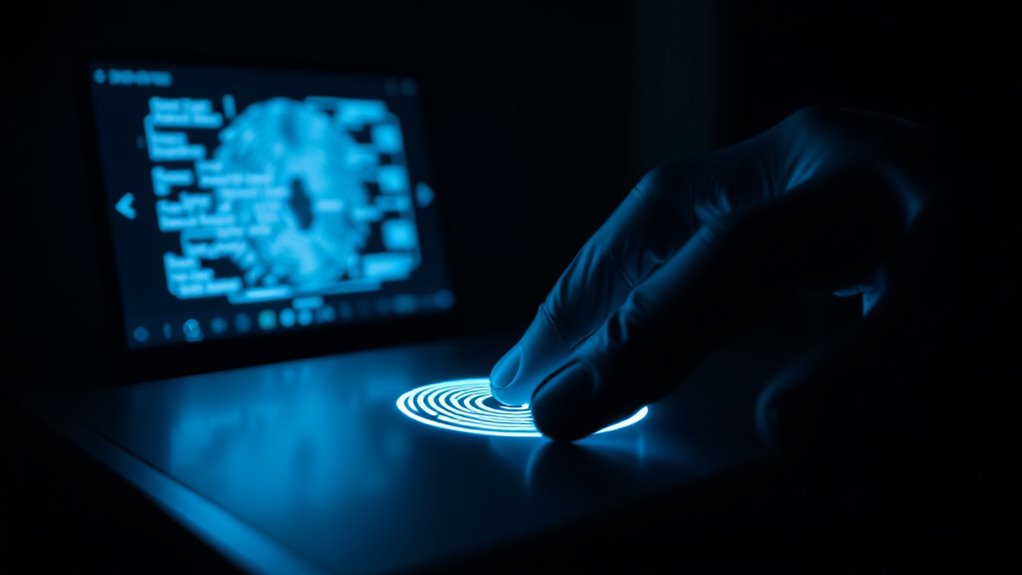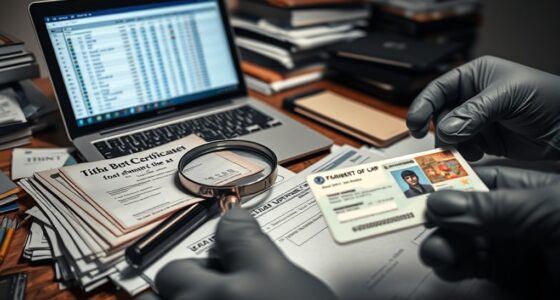Hackers can steal your fingerprints through digital breaches of biometric databases. Since biometric data is stored electronically, it becomes a target for theft, and unlike passwords, you can’t change your fingerprints if they’re stolen. The attackers may create fake templates or use facial scans to bypass security. Protecting your biometric info is challenging due to ongoing vulnerabilities, and if you’re curious about how these risks can be managed, there’s more to uncover.
Key Takeaways
- Hackers can potentially steal digital fingerprint templates stored in compromised systems.
- Physical fingerprints are difficult to steal directly, but fake fingerprint replicas can be created from biometric data.
- Stolen biometric data cannot be changed like passwords, increasing long-term security risks.
- Advanced hacking techniques target cryptographic systems protecting fingerprint data during storage and transmission.
- Breached fingerprint databases can be sold or misused for impersonation and unauthorized access.

As more organizations adopt biometric authentication methods, the risk of biometric data theft has become a pressing concern. When your fingerprints, facial scans, or iris patterns are stored digitally, they become attractive targets for hackers. Unlike passwords, biometric data isn’t something you can change if compromised, making the stakes much higher. You might think that advanced security measures can prevent such breaches, but the reality is more complicated. Cryptography challenges pose significant hurdles in safeguarding biometric information. Encryption can protect data at rest and during transmission, but attackers continuously seek vulnerabilities in algorithms or implementation flaws. If cryptographic systems are compromised, your biometric data could be stolen or manipulated, with potentially devastating consequences. Furthermore, because biometric data is inherently unique to you, its theft raises serious legal privacy implications. Laws and regulations around biometric data are still evolving, and many jurisdictions lack clear frameworks for handling breaches. You might find your biometric information being used without your consent or knowledge, leading to privacy violations that are hard to rectify.
Biometric data theft risks threaten privacy, security, and legal rights, demanding stronger encryption and transparent protections.
When your biometric data is stolen, hackers can use it for identity theft, fraud, or unauthorized access to secure systems. They may create fake fingerprints or facial reconstructions to bypass security measures, especially if biometric templates are stored improperly or without robust encryption. The concern isn’t just about theft; it’s about what happens afterward. If hackers gain access to biometric repositories, they can potentially sell this data on the dark web or use it for malicious purposes. You might not even realize your data has been compromised until it’s too late, and by then, the damage could be extensive.
On the legal side, organizations face increasing pressure to protect biometric data because of the privacy implications involved. Regulations like GDPR in Europe and CCPA in California demand strict handling and security of personal data, including biometrics. Failure to comply can lead to hefty fines and damage to reputation. As an individual, you may worry about how your biometric data is stored and whether proper safeguards are in place. You might also question the transparency of organizations in how they handle your sensitive information. The legal privacy implications are complex because biometric data touches on fundamental rights to privacy and control over personal information. If a breach occurs, legal battles, penalties, and loss of trust can follow, emphasizing the importance of robust security measures and clear policies to protect your biometric identity.
In the end, while biometric authentication offers convenience, it also introduces new vulnerabilities. The cryptography challenges and legal privacy implications are critical factors to contemplate when evaluating its security. Protecting your biometric data requires ongoing efforts from organizations to strengthen encryption, enforce strict privacy laws, and ensure transparency. Otherwise, your unique biological traits could easily become the next target for hackers, with consequences far beyond simple inconvenience.
Frequently Asked Questions
Can Biometric Data Be Legally Protected Against Theft?
Legal protections for biometric data, like fingerprints, vary depending on privacy legislation in your area. You have rights under laws designed to safeguard personal information, but these protections aren’t foolproof. You should stay informed about current privacy laws and advocate for stronger regulations. While legislation aims to prevent theft, taking personal precautions and understanding your rights help ensure your biometric data remains secure against potential threats.
What Are the Best Ways to Secure Your Fingerprint Data?
Did you know that over 60% of biometric breaches could be prevented? To secure your fingerprint data, use biometric encryption, which scrambles your information, making it unreadable without a key. Also, consider fingerprint masking techniques that distort your prints, preventing unauthorized scans. Regularly update your device’s security settings and avoid sharing biometric info openly. Taking these steps helps protect your sensitive data from potential hackers.
Are Biometric Data Breaches More Damaging Than Password Leaks?
You might wonder if biometric data breaches are worse than password leaks. While both threaten your privacy, biometric breaches often cause more damage because your fingerprints can’t be altered like passwords. Hackers can use stolen biometric data for identity theft or unauthorized access. That’s why, to protect yourself, you should prioritize privacy concerns and guarantee your data is secured with strong data encryption methods, making breaches less likely and less harmful.
How Do Courts View Biometric Data Theft Cases?
Did you know that biometric data theft cases have increased by 300% over the past five years? Courts typically view biometric data theft as a serious violation of privacy rights. They rely on legal precedents that treat biometric information like personal property, leading to rulings that favor victims. Courts now emphasize the need for strict security measures and hold offenders accountable, setting a strong legal stance against biometric data breaches.
Can Stolen Fingerprints Be Used to Commit Identity Fraud?
Yes, stolen fingerprints can be used to commit identity impersonation through fingerprint forgery. Hackers might replicate your fingerprints to unlock devices or access secure accounts, enabling identity fraud. This can lead to serious consequences, such as financial theft or legal issues. To protect yourself, it’s essential to stay vigilant, use multi-factor authentication, and monitor your accounts closely for any suspicious activity.
Conclusion
While your fingerprints seem unique and secure, they can still be stolen, exposing you to real risks. Unlike passwords, they can’t be changed once compromised, making your identity vulnerable forever. It’s ironic that the very features meant to protect you could become your greatest weakness. As technology advances, so do hackers’ methods. Stay vigilant, because even the safest biometric data isn’t foolproof, and sometimes, your most personal identifiers can become your greatest liability.








